
IRELAND’S ISLANDS CARSTEN KRIEGER & RICHARD CREAGH
CARSTEN KRIEGER & RICHARD CREAGH IRELAND’S ISLANDS
CARSTEN KRIEGER is a professional photographer and author based in the west of Ireland. His unique images are highly acclaimed and over the past decade he has become one of Ireland’s foremost photographers covering various topics from landscape and nature to architecture and food photography. He has published numerous books on Ireland’s landscape, wildlife and heritage including Ireland’s Ancient East, Ireland’s Coast and the popular Ireland’s Wild Atlantic Way
RICHARD CREAGH is a professional nature, wildlife and adventure photographer based in the south west of Ireland. He has worked in nature tourism in Mayo, Clare, and most currently as a guide on marine tour boats around The Blasket Islands, off West Kerry. With David Flanagan, Richard is the author of Exploring Ireland’s Wild Atlantic Way
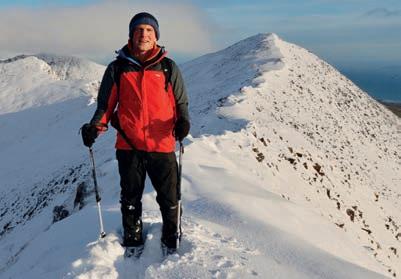
First published 2022 by The O’Brien Press Ltd, 12 Terenure Road East, Rathgar, Dublin 6, D06 HD27, Ireland.
Tel: +353 1 4923333; Fax: +353 1 4922777 E-mail: books@obrien.ie Website: obrien.ie
The O’Brien Press is a member of Publishing Ireland
ISBN: 978-1-84717-976-0
Text & photography © copyright Carsten Krieger & Richard Creagh 2022 The moral rights of the authors have been asserted Copyright for typesetting, layout, editing, design
© The O’Brien Press Ltd
Cover Design by Emma Byrne
All rights reserved. No part of this publication may be reproduced or utilised in any form or by any means, electronic or mechanical, including photocopying, recording or in any information storage and retrieval system, without permission in writing from the publisher. 8 7 6 5 4 3 2 1 26 25 24 23 22
Printed by L&C Printing Group, Poland.
Published in:
Photographs by Carsten Krieger: Away from it all; Dursey Island; Valentia Island; Aran Islands; Achill Island (except p 143 bottom by Richard Creagh); Arranmore.
Photographs by Richard Creagh: Front cover (The Skelligs); My Island Story; Sherkin Island; Cape Clear; Bere Island; The Skelligs; Blasket Islands; Inishbofin; Inishturk & Caher Island; Clare Island (except p 122 by Carsten Krieger); Tory Island; Rathlin Island (except p 169 bottom right by Carsten Krieger); Ireland’s Eye & Dalkey Island; The Saltee Islands (except p 182, p 183, p 185 bottom, p 187 top, p 189 bottom, all by Carsten Krieger).
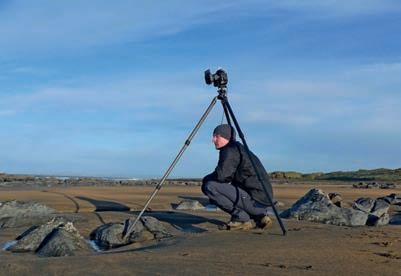
CONTENTS
Map of Ireland’s Islands 04
Away from it all: A photographer’s escape to the islands
– Carsten Krieger 05
My Island Story – Richard Creagh 08
Sherkin Island 11
Cape Clear 21
Bere Island 34
Dursey Island 44
The Skelligs 54
Valentia Island 67
The Blaskets 78
Aran Islands 89
Inishbofin 100
Inishturk & Caher Island 112
Clare Island 122
Achill Island 133
Arranmore 143
Tory Island 154
Rathlin Island 165
Ireland’s Eye & Dalkey Island 174
The Saltee Islands 182
4 IRELAND’S ISLANDS Sligo Meath Dublin Mayo Galway Clare Kerry Cork Limerick Roscommon Tipperary Waterford Leitrim Donegal Fermanagh Derry/ Londonderry Tyrone Cavan Down Antrim Armagh Monaghan Louth Wicklow Wexford Carlow Kildare Westmeath Longford Offaly Laois Kilkenny RATHLIN ISLANDTORY ISLAND ARRANMORE ACHILL ISLAND INISHTURK INISHBOFIN CLARE ISLAND ARAN ISLANDS BLASKET ISLANDS VALENTIA ISLAND THE SKELLIGS DURSEY ISLAND BERE ISLAND SHERKIN ISLAND CAPE CLEAR SALTEE ISLANDS DALKEY ISLAND IRELAND’S EYE CAHER ISLAND
AWAY FROM IT ALL:
A PHOTOGRAPHER’S ESCAPE TO THE ISLANDS – CARSTEN KRIEGER
The idea for this project was born almost twenty years ago when I first set foot on Arranmore Island off the coast of Donegal. Anyone who has ever visited one of Ireland’s offshore islands would agree that the atmosphere changes the moment you step off the ferry. Islands are different, there is a strong sense of place, a presence and a calmness that has disappeared from most areas of the mainland. Heritage and traditions are more openly appreciated and celebrated on the islands and life is more in tune with the weather, landscape and the seasons.
However, it took over a decade for the promise of a book on Ireland’s islands to begin to become a reality. Other assignments and life in general got in the way. Finally, in the summer of 2018, I set out on my first trip for Ireland’s Islands and sailed to the place where I first had the idea for this book, Arranmore Island. I had two weeks of wonderful weather and savoured every minute of it; I felt like this dream project had finally sprung to life.
Unfortunately, the dream ended after this trip. The funding to pay for the higher than usual
Below: Inisheer, Aran Islands, County Galway.
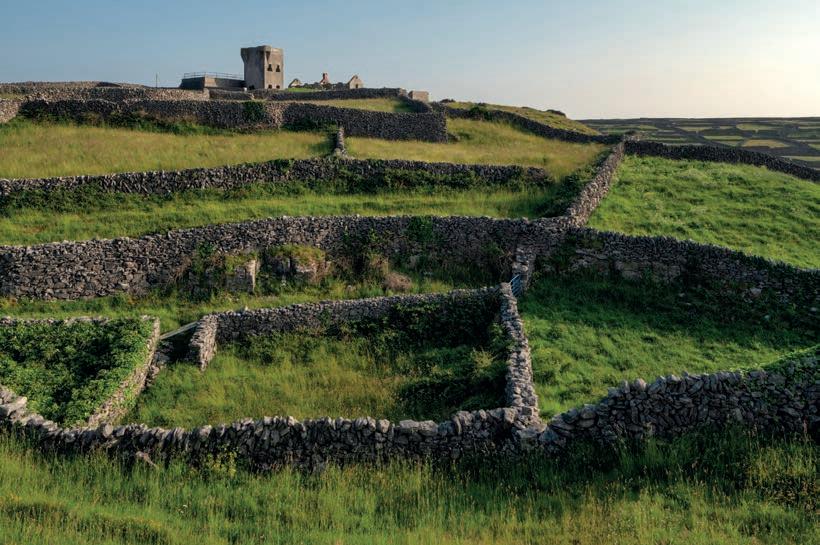
5
Above: Scattery Island, County Clare.
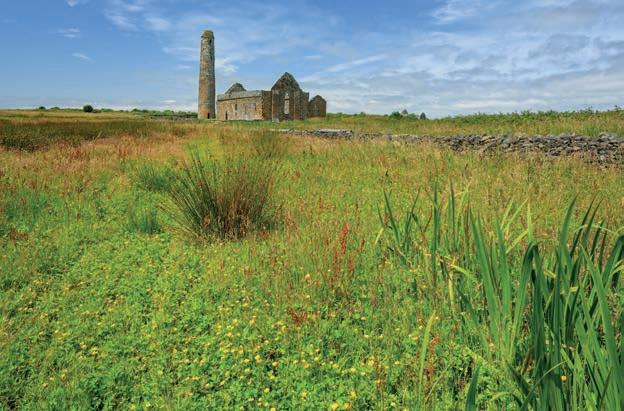
Below: Dursey Island, County Cork.
expenses of these excursions failed to materialise and the weather turned on me. I’ve lost count of the times I sat in a ferry terminal only to be told that the boat wouldn’t be departing because of bad weather or the times I made it to an island only to stare out a window into pouring rain and go home without a single usable image. It was almost like the islands were reminding me that island life isn’t as easy as it might appear to be during those long summer days in the sunshine. So, the project dragged on, deadlines were postponed again and again and then the Covid-19 pandemic hit, grounding me as well as any hope of completing the island project.

6 IRELAND’S ISLANDS
During the first lockdown I decided I needed help and reached out to the wonderful Richard Creagh who thankfully agreed to join me. In the end Richard not only joined, but saved the project. I am more than happy he put his stamp on this book. It is all the better for it.

Still, this isn’t the book I had envisaged all those years ago. My usual approach is one of carefully planning every image and arranging trips accordingly. This process went very much out the window. Travel had to take place when the weather and pandemic restrictions allowed it and consequently this book is rather spontaneous in nature. Rather than the carefully crafted portrait I had in mind, it’s more of a snapshot of Ireland’s islands in the early twenty-first century. In retrospect this is no bad thing and I hope you will enjoy the trip.
Carsten Krieger,
 Above: Arranmore Island, County Donegal.
Below: Eagle Island, County Mayo.
Above: Arranmore Island, County Donegal.
Below: Eagle Island, County Mayo.
AWAY FROM IT ALL : A PHOTOGRAPHER ’ S ESCAPE TO THE ISLANDS – CARSTEN KRIEGER 7
January 2022
MY ISLAND STORY – RICHARD CREAGH
When I was around fifteen my dad came home one day with the gift of a book; Oileáin, a superb guide to Ireland’s islands by David Walsh.
The huge amount of information and in particular the pictures – of places I found hard to believe existed anywhere, let alone the country I lived in – were greatly inspiring to a teenager longing to escape west from the suburbs.
Family trips to Sherkin and a summer spent on Cape Clear were early introductions to the islands for me, and those good times fuelled visits to our other offshore islands in the years since. These trips have taken many forms - kayaking adventures with friends, unusual work opportunities (like hauling heavy film equipment up and down Skellig Michael) and laid-back summer days wandering the coast of some small, peaceful, sea-locked world. The wilder aspects are what drew me to the islands initially. Huge rugged cliffs, exposed headlands, broken stacks and cavernous sea caves all inspired long days of exploration, each feature enticing me on to see what might be around the next corner.
Below: Sea kayaking on the west coast of Sherky Island, County Kerry.

Opposite top left: Stone cross at Illauntannig monastery, Maharees, County Kerry.
Opposite top right: View across the tidal strand to Omey Island, Connemara, County Galway.
8
Island wildlife soon started to grab my attention, in particular the seabirds. The sights, sounds and smells of colonies thick with auks, kittiwakes, fulmars, gannets and other oceanic wanderers is one of the greatest seasonal highlights for me. The physical limitations of islands add a further allure. The shrinking of your world to an area often encompassed within your field of vision suggests the potential to get to know a place intimately. Tim Robinson put it well when he wrote how ‘a mainland area with its ambiguous or arbitrary boundaries doesn’t constrain the attention in the same way.’ An island however ‘holds out the delusion of a comprehensible totality.’ These are places where it’s easy to dream, if only foolishly, of escaping to another world.
In more recent years, while making trips for this book, I developed a deeper appreciation for the islands – and especially for the uniqueness of the communities on those islands that still home

Below left: Evening sunshine on the amazing north coast of Tory Island, County Donegal.

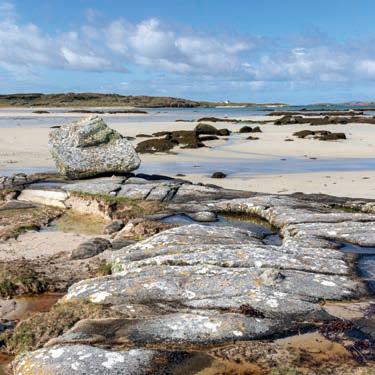
Below right: Common dolphin off the Saltee Islands, County Wexford.
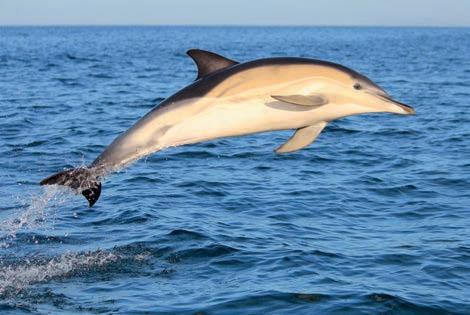
M Y I SLAND S T ORY – RICHARD CREAGH 9
people. As a visitor, it’s all too easy to marvel at the charm of the islands while rooted in the comfort of the mainland. But despite all the conveniences of modernity, the islanders face many challenges unknown to the rest of us. Nearly all the populations of the inhabited islands are in decline, continuing a trend that has seen dozens of communities dwindle away to nothing over the last century. The exodus of young people from rural areas is felt more sharply here than on the mainland; without significant state help the future remains uncertain for many of those who live offshore. The tendency for islands to produce distinct variation is a well-studied concept in biology, and humans, of course, are as susceptible to this phenomenon as any other species. We stand to lose an awful lot of local knowledge, history, dialects, ways of thinking and living, along with all the other intangible intricacies that make up the whole of a vibrant life if these populated islands are unable to maintain their viability. It is the distinctness of island culture that sets itself apart from the uniformity of mainland life; the islanders deserve every opportunity to continue their unique ways of living.
This book offers a glimpse into just some of Ireland’s islands. To make a book of this kind inclusive of the hundreds of islands off our stormy coast would be a life-long project. Nonetheless, these pages will hopefully inspire visits to some of these special places, as well as offering new insights to those who already know them. My thanks to Carsten for inviting me to join him in putting this book together, and to the islanders who helped make it happen.
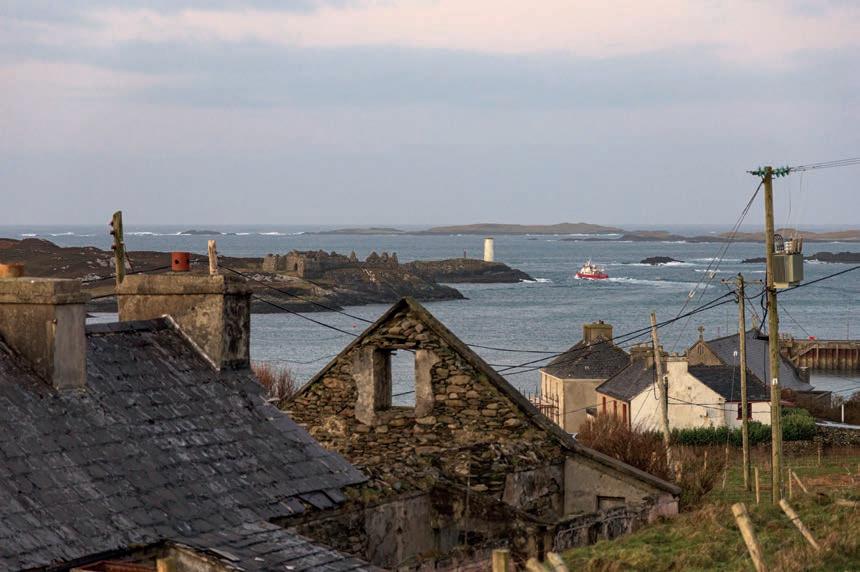 Richard Creagh, 2022
Above: The Inishbofin ferry leaving for the mainland on a winter morning.
Richard Creagh, 2022
Above: The Inishbofin ferry leaving for the mainland on a winter morning.
10 IRELAND’S ISLANDS
SHERKIN ISLAND – COUNTY CORK

Every summer of my childhood, my family would head away to Baltimore to take the short ferry trip to Sherkin Island. We would have a picnic on Silver Strand, poke around rock pools, bury each other in the sand for fun, and always finish the day by jumping off the pier, and the higher pier wall as we got older and braver. The weather was always nice (no doubt due to my parents’ careful planning rather than an eternally sunny climate), and the day was always a highlight of the summer. So I’m not the most objective observer to be writing about it, but I think most who’ve been there would agree that Sherkin Island is a very special place indeed.
Despite sitting less than two kilometres from Baltimore Harbour, and less than 400m from the closest point on the mainland, Sherkin retains the atmosphere of a place apart from the busyness of mainland life. This characteristic is consistent among almost all the Irish islands, despite the variety of landscapes and cultures that define them. This sense of charmed isolation may appeal to the city-
Below: Late summer scene at Sherkin pier.
11
living tourists who visit for brief spells in summer holiday mode, but the depopulation of Ireland’s islands is a serious threat to those who still live on them, and despite its proximity to the mainland Sherkin is no different in following the general trend of abandonment. But all is not doom and gloom.

Though Sherkin’s primary school closed in 2016 it was not the end to formal education on the island. Naturally, the beauty of the island has attracted artists for a long time, and this draw has become such that aspiring students can complete a BA in Visual Arts on Sherkin, a first for any Irish island. Exhibitions are held at multiple times throughout the year, both through this course and other local community efforts, and a significant proportion of the island’s population is now made up of painters, photographers and other craftspeople. Sherkin is also home to one of the longest-running marine research stations in the world. Founded in 1975, the Sherkin Island Marine Station is a completely independent research body that monitors baseline data on the marine life of much of the Cork coast. This includes monitoring plankton levels, gathering meteorological data and conducting bird surveys, among much else, to assess how the fortunes of species and functioning of these ecosystems is changing with time. Through publishing scientific papers, guidebooks on local flora and fauna and its own science-based newspaper the Station aims to

12 IRELAND’S ISLANDS
Opposite top: Sherkin Friary reflected in a puddle on the quay.
Opposite bottom: Sunrise at Sherkin’s sheltered harbour.
Above left: Mute swans in Kinish Harbour.

Right: The small quay at Sherkin’s northernmost point.

Below: The fifteenth-century Franciscan Friary at dawn.

S HERKIN I SLAND – C OUNTY C ORK 13
create awareness and knowledge of the marine environment that surrounds the Irish seaboard, as well as highlight threats it faces and opportunities it presents for coastal communities.
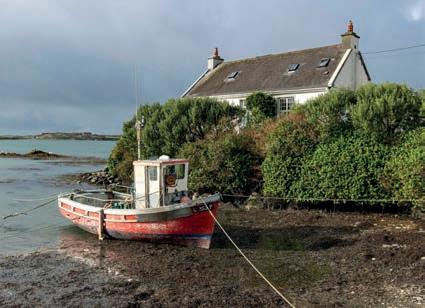
Sherkin’s landscape is quite varied; between a mixture of low rough hillsides, agricultural grassland, old hedgerows and stone walls, small stands of woodland, freshwater lakes and saltmarsh, and a shoreline that ranges from steep cliffs to soft sandy beaches, there is habitat for a wide range of species. Being so close to the mainland and sheltered from the worst of the open ocean’s weathers means Sherkin doesn’t have quite the same dramatic starkness of landscape found on many islands further up the coast, but what it lacks in drama it more than makes up for with a much more hospitable climate. Ferns grow well in the mild, humid atmosphere, as do many other plant species; of all the islands in Roaringwater Bay, Sherkin has the largest recorded flora. While many of the lesser-known species will go unnoticed by most visitors, even those who’ve never opened a wildflower guide would be hard pressed to miss the orchids in the summer or the pinks and yellows of heathers and western gorse that clothe the ungrazed hills in early autumn. Birds are also well represented on the island. Some resident breeders, such as the little egret and mute swan, are absent from almost all other islands in this book, and the total species list in any season is more than most areas of a similar size anywhere in Ireland, owing again to the diversity of terrain and the benevolent weather.
Before even setting foot on Sherkin, even before leaving Baltimore if you’re keen-eyed, most people will notice the Abbey overlooking the pier. Established in 1460 as a Franciscan Friary it had a reasonably short working life. By 1650 Cromwell’s forces had it cleared, though it was subjected to similar strife through local clan disputes long before this. Perhaps the most intriguing aspect of the Abbey’s history, however, is the discovery of sixteenth-century Chinese porcelain during an excavation of the grounds. While in today’s city-centric world places like Sherkin appear as if they’ve always been quiet backwaters, this find is an important reminder that the reverse is actually the case. Long before the invention of combustion engines and travel by rail, road and plane people moved primarily by sea. Islands such as Sherkin were on the frontlines of these routes, and were hubs of commerce and global human activity, while many of the areas inland from the coast were wooded wildernesses. It may be hard to imagine these days, while lounging as a tourist on one of Sherkin’s perfect beaches, or walking a fuchsia-lined laneway in late August sunshine, but places like Sherkin have undergone unthinkable change, and will continue to do so as sure as the tides will come and go.
Richard Creagh
Below left: Jo Ashby in her studio. Sherkin’s beauty has attracted a significant number of artists to come and live there.
Below right: Fishing boat tied up in the shelter of Kinish Harbour. Opposite: Moon shining on a quiet road before dawn.

14 IRELAND’S ISLANDS

S HERKIN I SLAND – C OUNTY C ORK 15

 Above: Sherkin lighthouse, marking the southern entrance to Baltimore Harbour. Below: Sherkin’s sheltered position and benign climate (as well as a lack of open grazing) mean it has what many of Ireland’s islands are sorely lacking – trees.
Above: Sherkin lighthouse, marking the southern entrance to Baltimore Harbour. Below: Sherkin’s sheltered position and benign climate (as well as a lack of open grazing) mean it has what many of Ireland’s islands are sorely lacking – trees.
16 IRELAND’S ISLANDS

 Above: Kinish Harbour at dawn.
Below: Evening at Silver Strand.
Above: Kinish Harbour at dawn.
Below: Evening at Silver Strand.
S HERKIN I SLAND – C OUNTY C ORK 17

18 IRELAND’S ISLANDS
Opposite: Cow Strand on a beautiful September day.
Left: Robin singing its song on a bramble.

Below: Trá Bán, one of the quieter beaches on the island.

19
